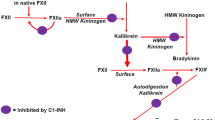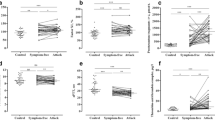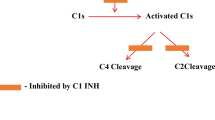Abstract
Plasma of patients with types I and II hereditary angioedema is unstable if incubated in a plastic (i.e., inert) vessel at 37 °C manifested by progressively increasing formation of bradykinin. There is also a persistent low level of C4 in 95 % of patients even when they are symptomatic. These phenomena are due to the properties of the C1r subcomponent of C1, factor XII, and the bimolecular complex of prekallikrein with high molecular weight kininogen (HK). Purified C1r auto-activates in physiologic buffers, activates C1s, which in turn depletes C4. This occurs when C1 inhibitor is deficient. The complex of prekallikrein-HK acquires an inducible active site not present in prekallikrein which in Tris-type buffers cleaves HK stoichiometrically to release bradykinin, or in phosphate buffer auto-activates to generate kallikrein and bradykinin. Thus immunologic depletion of C1 inhibitor from factor XII-deficient plasma (phosphate is the natural buffer) auto-activates on incubation to release bradykinin. Normal C1 inhibitor prevents this from occurring. During attacks of angioedema, if factor XII auto-activates on surfaces, the initial factor XIIa formed converts prekallikrein to kallikrein, and kallikrein cleaves HK to release bradykinin. Kallikrein also rapidly activates most remaining factor XII to factor XIIa. Additional cleavages convert factor XIIa to factor XIIf and factor XIIf activates C1r enzymatically so that C4 levels approach zero, and C2 is depleted. There is also a possibility that kallikrein is generated first as a result of activation of the prekallikrein-HK complex by heat shock protein 90 released from endothelial cells, followed by kallikrein activation of factor XII.







Similar content being viewed by others
References
Fields T, Ghebrehiwet B, Kaplan AP (1983) Kinin formation in hereditary angioedema plasma: evidence against kinin derivation from C2 and in support of “spontaneous” formation of bradykinin. J Allergy Clin Immunol 72(1):54–60
Joseph K, Kaplan A (2013) Factor XII independent activation of the bradykinin-forming cascade: implications for the pathogenesis of hereditary angioedema types I and II. J Allergy Clin Immunol 132:470–475
Ziccardi RJ (1982) Spontaneous activation of the first component of human complement (C1) by an intramolecular autocatalytic mechanism. J Immunol 128(6):2500–2504
Arlaud GJ, Villiers CL, Chesne S, Colomb MG (1980) Purified C1r: some characteristics of its activation and subsequent proteolytic cleavage. Biochim Biophys Acta 616:116–129
Joseph K, Tholanikunnel B, Kaplan A (2009) Factor XII-independent cleavage of high molecular weight kininogen by prekallikrein and inhibition by C1 inhibitor. J Allergy Clin Immunol 124:143–149
Weiss R, Silverberg M, Kaplan AP (1986) The effect of C1 inhibitor upon Hageman factor autoactivation. Blood 68(1):239–243
Zuraw B (2008) Clinical practice. Hereditary angioedema. N Engl J Med 359(10):1027–1036
Strang C, Siegel R, Phillips M, Poon P, Schumaker V (1982) Ultrastructure of the first component of human complement: electron microscopy of the crosslinked complex. Proc Natl Acad Sci U S A 79(2):586–590
Ratnoff O, Pensky J, Ogston D, Naff G (1969) The inhibition of plasmin, plasma kallikrein, plasma permeability factor, and the C’1r subcomponent of the first component of complement by serum C’1 esterase inhibitor. J Exp Med 129(2):315–331
Austen K, Sheffer A (1965) Detection of hereditory angioneurotic edema by demonstration of a reduction in the second component of human complement. N Engl J Med 272:649–656
Donaldson V, Evans R (1963) A biochemical abnormality in hereditary angioneurotic edema. Am J Med 35:37–44
Pensky J, Levy L, Lepow I (1961) Partial purification of a serum inhibitor of C’1-esterase. J Biol Chem 236:1674–1679
Donaldson VH, Rosen FS, Bing DH (1977) Role of the second component of complement (C2) and plasmin in kinin release in hereditary angioneurotic edema (H.A.N.E.) plasma. Trans Assoc Am Phys 90:174–183
Donaldson VH (1968) Mechanisms of activation of C’1 esterase in hereditary angioneurotic edema plasma in vitro. J Exp Med 127(3):411–429
Strang C, Auerbach H, Rosen F (1986) C1s-induced vascular permeability in C2-deficient guinea pigs. J Immunol 137(2):631–635
Klemperer MR, Donaldson VH, Rosen FS (1968) Effect of C’1 esterase on vascular permeability in man: studies in normal and complement-deficient individuals and in patients with hereditary angioneurotic edema. J Clin Investig 47(3):604–611
Gigli I, Mason JW, Colman RW, Austen KF (1970) Interaction of plasma kallikrein with the C1 inhibitor. J Immunol 104(3):574–581
Schreiber A, Kaplan A, Austen K (1973) Inhibition by C1INH of Hagemann factor fragment activation of coagulation, fibrinolysis, and kinin generation. J Clin Invest 52(6):1402–1409
Kaplan AP, Austen KF (1970) A pre-albumin activator of prekallikrein. J Immunol 105(4):802–811
Kaplan AP, Austen KF (1971) A prealbumin activator of prekallikrein. II. Derivation of activators of prekallikrein from active Hageman factor by digestion with plasmin. J Exp Med 133(4):696–712
Pierce J, Webster M (1966) The purification and same properites of two different kallidinogen’s from human plasma. In: Erdos E, Back N, Sicuteri F (eds) Hypotensive peptides. Springer-Verlag, New York, pp 130–138
Silverberg M, Dunn J, Garen L, Kaplan A (1980) Autoactivation of human Hageman factor. Demonstration utilizing a synthetic substrate. J Biol Chem 255(15):7281–7286
Cochrane CG, Revak SD, Wuepper KD (1973) Activation of Hageman factor in solid and fluid phases. A critical role of kallikrein. J Exp Med 138(6):1564–1583
Weiss AS, Gallin JI, Kaplan AP (1974) Fletcher factor deficiency. A diminished rate of Hageman factor activation caused by absence of prekallikrein with abnormalities of coagulation, fibrinolysis, chemotactic activity, and kinin generation. J Clin Investig 53(2):622–633
Griffin JH (1978) Role of surface in surface-dependent activation of Hageman factor (blood coagulation factor XII). Proc Natl Acad Sci U S A 75(4):1998–2002
Dunn JT, Silverberg M, Kaplan AP (1982) The cleavage and formation of activated human Hageman factor by autodigestion and by kallikrein. J Biol Chem 257(4):1779–1784
Dunn JT, Kaplan AP (1982) Formation and structure of human Hageman factor fragments. J Clin Investig 70(3):627–631
Fujikawa K, McMullen BA (1983) Amino acid sequence of human beta-factor XIIa. J Biol Chem 258(18):10924–10933
Mandle R, Colman R, Kaplan A (1976) Identification of prekallikrein and high-molecular-weight kininogen as a complex in human plasma. Proc Natl Acad Sci 73(11):4179–4183
Curd J, Prograis LJ, Cochrane C (1980) Detection of active kallikrein in induced blister fluids of hereditary angioedema patients. N Engl J Med 152(3):742–747
Smith M, Kerr M (1985) Cleavage of the second component of complement by plasma proteases: implications in hereditary C1-inhibitor deficiency. Immunology 56(3):561–570
Shoemaker L, Schurman S, Donaldson V, Ar D (1994) Hereditary angioneurotic oedema: characterization of plasma kinin and vascular permeability-enhancing activities. Clin Exp Immunol 95(1):22–28
Nussberger J, Cugno M, Cicardi M, Agostoni A (1999) Local bradykinin generation in hereditary angioedema. J Allergy Clin Immunol 104(6):1321–1322
Zahedi R, Bissler J, Ar D, Andreadis C, Wisnieski J (1995) Unique C1 inhibitor dysfunction in a kindred without angioedema. II. Identification of an Ala443→val substitution and functional analysis of the recombinant mutant protein. J Clin Invest 95(3):1299–1305
Han E, MacFarlane R, Mulligan A, Scafidi J, Ar D (2002) Increased vascular permeability in C1 inhibitor-deficient mice mediated by the bradykinin type 2 receptor. J Clin Invest 8(8):1057–1063
Kaplan A, Ghebrehiwet B (2004) Does C-2 kinin exist? J Allergy Clin Immunol 115(4):876
Ratnoff O, Colopy J (1955) A familial hemorrhagic trait associated with a deficiency of a clot-promoting fraction of plasma. J Clin Invest 34(4):02–12
Margolis J (1963) The interrelationship of coagulation of plasma and release of peptides. Ann N Y Acad Sci 104:133–145
Cochrane C, Wuepper K (1971) The first component of the kinin-forming system in human and rabbit plasma. Its relationship to clotting factor XII (Hageman Factor). J Exp Med 134(4):986–1004
Revak S, Cochrane C, Bouma B, Griffin J (1978) Surface and fluid phase activities of two forms of activated Hageman factor produced during contact activation of plasma. J Exp Med 147(3):719–729
Miller G, Silverberg M, Kaplan AP (1980) Autoactivatability of human Hageman factor (factor XII). Biochem Biophys Res Commun 92(3):803–810
Tankersley DL, Finlayson JS (1984) Kinetics of activation and autoactivation of human factor XII. Biochemistry 23(2):273–279
Silverberg M, Kaplan AP (1982) Enzymatic activities of activated and zymogen forms of human Hageman factor (factor XII). Blood 60(1):64–70
Scott CF, Colman RW (1980) Function and immunochemistry of prekallikrein-high molecular weight kininogen complex in plasma. J Clin Investig 65(2):413–421
Thompson R, Mandle RJ, Kaplan A (1977) Association of factor XI and high molecular weight kininogen in human plasma. J Clin Invest 60(6):1376–1380
Schmaier AH, Kuo A, Lundberg D, Murray S, Cines DB (1988) The expression of high molecular weight kininogen on human umbilical vein endothelial cells. J Biol Chem 263(31):16327–16333
Schmaier AH, Rojkjaer R, Shariat-Madar Z (1999) Activation of the plasma kallikrein/kinin system on cells: a revised hypothesis. Thromb Haemost 82(2):226–233
Joseph K, Tholanikunnel B, Kaplan A (2002) Heat shock protein 90 catalyzes activation of the prekallikrein-kininogen complex in the absence of factor XII. Proc Natl Acad Sci 99(2):896–900
Griffin JH, Cochrane CG (1976) Mechanisms for the involvement of high molecular weight kininogen in surface-dependent reactions of Hageman factor. Proc Natl Acad Sci U S A 73(8):2554–2558
Silverberg M, Nicoll J, Kaplan A (1980) The mechanism by which the light chain of cleaved HMW-kininogen augments the activation of prekallikrein, factor XI and Hageman factor. Thromb Res 20(2):173–189
Hojima Y, Pierce JV, Pisano JJ (1980) Hageman factor fragment inhibitor in corn seeds: purification and characterization. Thromb Res 20(2):149–162
Hojima Y, Cochrane CG, Wiggins RC, Austen KF, Stevens RL (1984) In vitro activation of the contact (Hageman factor) system of plasma by heparin and chondroitin sulfate E. Blood 63(6):1453–1459
Brunnee T, Reddigari SR, Shibayama Y, Kaplan AP, Silverberg M (1997) Mast cell derived heparin activates the contact system: a link to kinin generation in allergic reactions. Clin Exp Allergy 27(6):653–663
Sala-Cunill A, Bjorkqvist J, Senter R, Guilarte M, Cardona V, Labrador M, Nickel K, Butler L, Luengo O, Kumar P, Labberton L, Long A, Di Gennaro A, Kenne E, Jamsa A, Krieger T, Schluter H, Fuchs T, Flohr S, Hassiepen U, Cumin F, McCrae K, Maas C, Stavrou E, Renne T (2015) Plasma contact system activation drives anaphylaxis in severe mast cell-mediated allergic reactions. J Allergy Clin Immunol 135(4):1031–1043
Puy C, Tucker E, Wong Z, Gailani D, Smith S, Choi S, Morrissey J, Gruber A, McCarty O (2013) Factor XII promotes blood coagulation independent of factor XI in the presence of long-chain polyphosphates. J Thromb Haemost 11(7):1341–1352
Joseph K, Tholanikunnel T, Kaplan A (2010) Treatment of episodes of hereditary angioedema with C1 inhibitor: serial assessment of observed abnormalities of the plasma bradykinin-forming pathway and fibrinolysis. Ann Allergy Asthma Immunol 104(1):50–54
Cugno M, Cicardi M, Coppola R, Agostoni A (1996) Activation of factor XII and cleavage of high molecular weight kininogen during acute attacks in hereditary and acquired C1-inhibitor deficiencies. Immunopharmacology 33(1-3):361–364
Ghebrehiwet B, Randazzo B, Dunn J, Silverberg M, Kaplan A (1983) Mechanisms of activation of the classical pathway of complement by Hageman factor fragment. J Clin Invest 71(5):1450–1456
Joseph K, Tholanikunnel B, Ghebrehiwet B, Kaplan A (2004) Interaction of high molecular weight kininogen biding proteins on endothelial cells. Thromb Haemost 91(1):61–70
Reddigari SR, Shibayama Y, Brunnee T, Kaplan AP (1993) Human Hageman factor (factor XII) and high molecular weight kininogen compete for the same binding site on human umbilical vein endothelial cells. J Biol Chem 268(16):11982–11987
Joseph K, Ghebrehiwet B, Peerschke EI, Reid KB, Kaplan AP (1996) Identification of the zinc-dependent endothelial cell binding protein for high molecular weight kininogen and factor XII: identity with the receptor that binds to the globular “heads” of C1q (gC1q-R). Proc Natl Acad Sci U S A 93(16):8552–8557
Mahdi F, Madar ZS, Figueroa CD, Schmaier AH (2002) Factor XII interacts with the multiprotein assembly of urokinase plasminogen activator receptor, gC1qR, and cytokeratin 1 on endothelial cell membranes. Blood 99(10):3585–3596
Rojkjaer R, Hasan AA, Motta G, Schousboe I, Schmaier AH (1998) Factor XII does not initiate prekallikrein activation on endothelial cells. Thromb Haemost 80(1):74–81
Shariat-Madar Z, Mahdi F, Schmaier A (2002) Identification and characterization of prolylcarboxypeptidase as an endothelial cell prekallikrein activator. J Biol Chem 277(20):17962–17969
Author information
Authors and Affiliations
Corresponding author
Rights and permissions
About this article
Cite this article
Kaplan, A.P., Joseph, K. Complement, Kinins, and Hereditary Angioedema: Mechanisms of Plasma Instability when C1 Inhibitor is Absent. Clinic Rev Allerg Immunol 51, 207–215 (2016). https://doi.org/10.1007/s12016-016-8555-6
Published:
Issue Date:
DOI: https://doi.org/10.1007/s12016-016-8555-6




